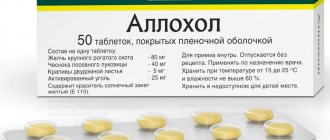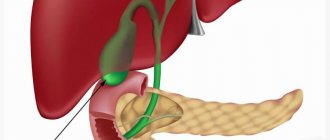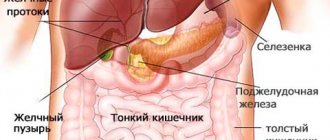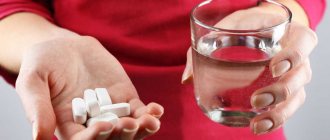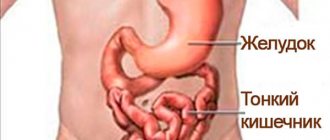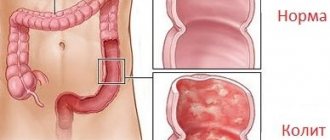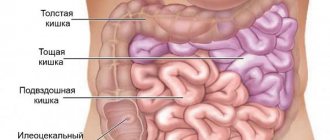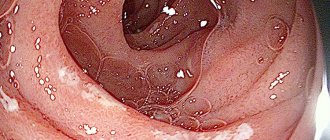09.25.201723.12.2020 Olga Migunova 4 comments
The gallbladder is a hollow organ of the digestive system, the main function of which is to collect bile and direct it, if necessary, to the small intestine, namely the duodenum.
Diseases of the gallbladder and biliary tract occupy leading positions in the structure of pathology of the digestive tract. Moreover, gallbladder pathology occurs more often in women than in men.
Considering the prevalence of this problem, we propose to consider in this topic the most common gallbladder diseases, symptoms and treatment of certain types of pathology. But first, we want to introduce you to the anatomy and functions of the gallbladder.
Gallbladder: anatomical features
The gallbladder is a hollow, pear-shaped organ with a wider base and a narrow distal end that merges into the cystic bile duct. Normally, the length of this organ is 80-140 mm, and the diameter is 30-50 mm.
The gallbladder is usually divided into three parts: neck, body and fundus. This organ is located on the lower surface of the liver in the fossa of the same name.
The wall of the gallbladder consists of three layers - serous, muscular and mucous. The mucous layer has many longitudinal folds.
The unchanged gallbladder cannot be palpated through the abdominal wall. The projection zone of this organ is located at the point of intersection of the outer edge of the rectus abdominis muscle and the right costal arch, which is called Ker’s point. In cases where the gallbladder is enlarged, it can be palpated.
Gallbladder: functions
The gallbladder functions as a reservoir in which bile is stored. Liver cells produce bile, which accumulates in the gallbladder. When a signal is received, bile enters the cystic duct, which flows into the common bile duct, and the latter opens into the duodenum.
In addition to the reservoir function, the organ has other purposes. Thus, mucus and acetylcholecystokinin are produced in the gallbladder, and nutrients are also reabsorbed.
Healthy people produce up to one liter of bile per day. The maximum capacity of the gallbladder is 50 ml.
Bile consists of water, bile acids, amino acids, phospholipids, cholesterol, bilirubin, proteins, mucus, some vitamins, minerals, and metabolites of medications that the patient is taking.
The bile is assigned the following tasks:
- neutralization of gastric juice;
- activation of the enzymatic ability of intestinal and pancreatic juice;
- neutralization of pathogenic microorganisms in the intestines;
- improvement of motor function of the intestinal tube;
- removal of toxins and drug metabolites from the body.
What tasks does the gallbladder perform?
The biliary ducts (bile ducts) are located inside the liver, in the central part of the lobules along with the vessels, and collect the secretion produced. The excretory system carries it to the gallbladder. This organ holds 40–70 ml of liquid and has a saccular structure with a rather thin wall.
It contains layers:
- mucous - formed by large folds of high epithelium;
- muscular - from smooth muscle bundles with the main circular direction;
- serous - protects the organ from the outside.
In the inner shell there are glands that secrete mucus, the hormone anticholecystokinin, and are capable of absorbing water, amino acids, and salts from the composition of bile. Thus, the composition and viscosity of the contents is regulated.
The excretory duct approaches the intestine together with the pancreatic duct. Here the muscles form a single sphincter, called Oddi by the author. After food enters the intestines, the gallbladder contracts and releases bile simultaneously with pancreatic juice.
An adult produces 0.5–1 liters of bile in 24 hours. In addition to water, the composition includes: bile acids, mucus, proteins and amino acids, inorganic substances, bilirubin, cholesterol, phospholipids, vitamins A, B, C, D.
Some of these substances are excreted in feces, others are absorbed in the intestines and enter the blood. Bile neutralizes the acidic reaction of gastric juice, activates the digestive enzyme systems, protects the intestinal mucosa from the growth of harmful bacteria, promotes peristalsis and the removal of toxic substances and waste from the body.
Gallbladder diseases: causes and mechanism of development
All causes of diseases of this organ can be divided into groups, namely:
- infectious. Viruses, bacteria, fungi and protozoa cause an inflammatory process in the mucous layer of the bladder, which is commonly called non-calculous cholecystitis. Most often, this disease is provoked by Escherichia coli, streptococci, staphylococci and Proteus;
- changes in bile when the balance of its components is disturbed. In this case, stones form in the bladder, which lead to the development of cholelithiasis. In cases where a calculus blocks the cystic bile duct, cholestasis syndrome occurs, that is, stagnation of bile;
- pathology of the receipt of nerve impulses to the gallbladder, resulting in a violation of the motor function of the gallbladder wall and difficulty in the outflow of bile into the small intestine;
- congenital genetic pathology. Most often, a congenital bend of this organ is observed;
- neoplasms in the gallbladder: polyps, malignant tumors.
Causes of development of gallbladder pathologies
The gallbladder (symptoms of organ disease and the causes of its occurrence manifest themselves differently in all people) can have several variants of pathologies:
- Gallstone disease is characterized by the appearance of small stone formations in the organ, which are eliminated through the digestive system. There are cases when the ducts become clogged and severe pain develops.
Symptoms of various gallbladder diseases are discussed in the article. - Hypomotor and hypermotor dysfunctions are disturbances in the processes in the contraction of the muscles of the walls of organs. As a result, accelerated or delayed flow of bile to the duodenum.
- Neoplasms appear to be a decrease in the functionality of the organ.
- Inflammatory pathologies arise due to a lot of stagnation of bile, infections, corrosion of the walls, and inflammation.
- If the movement of bile is disturbed, stagnation forms, the organ bends, stones form and inflammation occurs.
Gallbladder: brief description of diseases
- Cholelithiasis. This disease most often affects fair-haired women who have given birth over 40 years of age, who are overweight or obese. Stones are cholesterol, bilirubin brown and black, which can form in all parts of the biliary system. Rarely, only the gallbladder is affected. Gallstone disease is a long-term chronic disease with periods of exacerbation and remission. In the acute period, stones obstruct the cystic duct, as a result of which patients experience acute pain with other unpleasant symptoms. This combination of symptoms is commonly called hepatic colic.
- Chronic noncalculous cholecystitis. In this case, there are no stones, and inflammation of the mucous layer of the gallbladder is caused by an infectious agent, reflux of intestinal juice, diseases of the pancreas (pancreatitis), liver (hepatitis) or cholestasis.
- Biliary dyskinesia. This disease is characterized by the absence of organic changes in the gallbladder and ducts and occurs against the background of impaired innervation. Chronic stress, excessive physical and mental stress, and neurasthenia contribute to the development of dyskinesia. There are two types of dyskinesia - hyperkinetic, when intestinal peristalsis is too active, but chaotic, and hypokinetic, when bladder peristalsis is weakened.
- Acute cholangitis, or inflammation of the bile ducts. Almost always, this disease is caused by other diseases of the liver and gallbladder (cholecystitis, cholelithiasis, hepatitis, postcholecystectomy syndrome and others).
- Carcinoma. Malignant tumors in the gallbladder develop against the background of chronic inflammation. This type of tumor is characterized by high malignancy and the appearance of screenings in the early stages of the disease.
Gallbladder: where it is located and how it hurts
The bile produced by the liver flows through ducts into its intended reservoir - the gallbladder, which is located directly under the liver. It is also connected to the intestines by small tubules. When food enters the intestines, the bladder contracts, releasing a portion of the acidic liquid necessary for normal digestion.
Disturbances in the gallbladder and duct system can be signaled by various signs, the most characteristic of which are:
- Pain in the right hypochondrium, sometimes radiating to the right shoulder and right shoulder blade. Less often, pain spreads to the epigastric region.
- Indigestion with nausea and, in case of exacerbation, vomiting. Loose stools are replaced by periodic constipation.
- Dyspeptic symptoms (discomfort in the upper abdomen) increase with physical activity, consumption of junk food (fatty, fried, hot, spicy foods), sometimes with a change in body position or with a bumpy ride.
- When you belch, you feel bitterness in your mouth and heartburn appears.
- The color of waste products changes - urine becomes darker and feces become discolored.
- Palpation of the right hypochondrium is accompanied by increased pain.
- Changes in skin color (jaundice) are caused by blockage of one of the canals.
- Fever and chills are a sure sign of an exacerbation of the condition, requiring a quick response.
The nature and location of the disorders that arise depend on how the gallbladder hurts and what other pathological signs are present.
Correct diagnosis is the first step to eliminating the problem.
Therefore, when discomfort and other signs appear in the specified area, it is necessary to determine the type of disease.
Gallbladder: symptoms of the disease
What are the symptoms of gallbladder disease? Most gallbladder diseases have common symptoms.
Patients may experience the following symptoms:
- pain that is localized in the right hypochondrium. Moreover, the intensity of the pain syndrome is different for different diseases. For example, polyps are completely painless, but calculous cholecystitis or cholelithiasis cause acute severe pain.
- dyspeptic symptoms such as nausea, vomiting, bloating, diarrhea or constipation;
- bitterness in the mouth. In this case, it is necessary to carry out a thorough differential diagnosis, since this symptom may also accompany liver disease;
- redness of the tongue. This symptom is commonly called “raspberry tongue”;
- change in urine color. Due to cholestasis, a large amount of urobilinogen accumulates in the urine, which gives it the color of dark beer;
- discoloration of stool. Due to stagnation of bile, stercobilin does not enter the stool, which gives the stool a natural brown color;
- jaundice. With cholestasis, bile begins to be reabsorbed into the blood, as a result of which bile acids and bilirubin are deposited in the skin and mucous membranes. The sclera and oral mucosa turn yellow first, and only then the skin.
The listed symptoms and signs are the main ones for gallbladder diseases. But depending on the nosological form and course of the disease, other symptoms may occur, such as increased body temperature, general weakness, malaise, decreased appetite, and others.
Oncology
With a long course of gallbladder disease with the formation of stones, patients may develop a malignant neoplasm. The development of an oncological disease will be indicated by constant pain under the right rib, which does not subside with the use of medications. Dyspeptic disorders progress in the form of nausea and vomiting, loss of appetite and weight loss. Sometimes the patient is not bothered by pain attacks at all. Yellowness of the skin also does not appear.
The main indicator of tumor formation can be detected by palpation of the inflamed area. The bubble will be compacted, have a lumpy structure, and its palpation will cause almost no pain.
Gallbladder cancer
Gallbladder pain: symptoms
- With cholelithiasis, pain is localized in the right hypochondrium and can radiate to the right shoulder blade, shoulder, collarbone or left half of the body. The pain has an acute paroxysmal nature and is provoked by errors in nutrition.
- Chronic cholecystitis is manifested by aching pain, the intensity of which increases with a violation of the diet. Painful sensations are localized in the hypochondrium on the right, and sometimes in the epigastrium and can be projected to the right scapula, collarbone or shoulder.
- Dyskinesia of the gallbladder. In patients with the hyperkinetic type of dyskinesia, paroxysmal pain is observed. With hypokinetic dyskinesia, patients complain of a feeling of heaviness and fullness in the right hypochondrium or aching pain that radiates to the right half of the body, scapula, shoulder or collarbone.
- Acute cholangitis is manifested by quite severe pain, which can even cause painful shock. Localization and irradiation of pain similar to the diseases described above.
- Gallbladder carcinoma is asymptomatic for a long time. In the later stages of the disease, patients experience severe pain that is not relieved even by painkillers.
Dyskinesia of the gallbladder and biliary tract
A class of diseases in which the normal activity of the gallbladder is disrupted is commonly called dyskinesias. Dyskinesia can be hypomotor (insufficient activity) and hypermotor (too much activity). Both lead to deterioration of digestion due to disruption of the flow of bile into the duodenum.
The causes of dyskinesia are quite standard and generally repeat the causes of previous diseases:
Sedentary lifestyle
- Non-compliance with diet.
- Sedentary lifestyle.
- Violation of hormonal balance and metabolism.
- Digestive system problems (gastritis, ulcers).
- Chronic stress, nervousness, depression.
- Infection of an organ with worms or lamblia.
The main manifestation of dyskinesia is pain in the right hypochondrium after eating or exertion. The main role in the treatment of this disease is given to diet and getting rid of associated ailments.
Gallbladder: methods for diagnosing diseases
Diagnosis and treatment of gallbladder diseases is carried out by a general practitioner, gastroenterologist, surgeon or hepatologist. First of all, if symptoms of diseases of this organ appear, you need to contact a general practitioner, who, if necessary, will refer you to related specialists.
During an objective examination, the doctor must palpate the liver and gallbladder, with the help of which it is possible to determine pain points, that is, bladder symptoms, namely:
- Ker's symptom – pain on palpation of the gallbladder during inspiration;
- Georgievsky-Mussi symptom - the appearance of painful sensations when pressing on a point located between the legs of the right sternocleidomastoid muscle;
- Ortner-Grekov symptom - pain is provoked by tapping the edge of the palm on the right costal arch.
But complaints, anamnesis and objective data will not be enough to make an accurate diagnosis, so patients are prescribed the following additional studies:
- a general blood test, which is used to determine blood changes characteristic of the inflammatory process in the body;
- General and biochemical urine analysis can reveal increased levels of urobilinogen;
- the coprogram will show disturbances in digestive function;
- duodenal sounding. This method is performed using a thin rubber probe, which is placed through the oral cavity into the duodenum to collect portions of bile.
- chemical analysis of bile is used to study its composition.
- Bile culture suggests the etiology of the disease;
- Ultrasound examination of the abdominal organs. Using this method, you can study the anatomical features of the gallbladder and identify organic changes, inflammation and the presence of stones.
- biopsy, which is performed with a thin needle under ultrasound guidance. The resulting material is examined under a microscope for the presence of cancer cells.
- Cholangiography is an X-ray contrast examination of the gallbladder and bile ducts;
- Computed tomography is used primarily in gallbladder cancer to assess the prevalence of dropouts.
Treatment of gallbladder diseases
All patients are required to be prescribed a diet, the principles of which we will discuss below.
Etiotropic treatment involves the use of drugs that are aimed at eliminating the cause. For cholecystitis, antibacterial therapy is indicated; for stones, carcinoma or polyps of the gallbladder, surgical intervention is indicated.
Pathogenetic treatment involves the use of drugs that normalize the functioning of the gallbladder. For this purpose, antispasmodic, detoxification, anti-inflammatory and enzymatic drugs can be used.
Symptomatic treatment involves the prescription of painkillers, choleretic, antipyretic and other drugs. For pain, drugs such as Ketonal, Baralgin, Drotaverine, Spazmolgon and others can be used.
Among the myotropic antispasmodics, the drug Odeston attracts attention. It has a selective antispasmodic effect on the sphincter of Oddi and the sphincter of the gallbladder, and also has a choleretic effect. Combining antispasmodic and choleretic properties, Odeston ensures harmonious emptying of intra- and extrahepatic bile ducts, timely and unhindered flow of bile into the duodenum.
Odeston does not have a direct choleretic effect, but, by facilitating the flow of bile into the digestive tract, it enhances the recirculation of bile acids, which are involved in the first phase of bile formation. The advantage of Odeston over other antispasmodics is that it has virtually no effect on other smooth muscles, in particular those of the cardiovascular system and intestines.
Odeston simultaneously relaxes the sphincters of Oddi and Lutkens, therefore, unlike many choleretic drugs, it does not increase pressure in the biliary tract and, as a result, which is very important, does not provoke “biliary colic.” By increasing the flow of bile into the intestinal lumen, Odeston helps improve digestion and activates intestinal motility, which leads to normal stool.
We strongly do not recommend self-medication, as it does not always bring the expected effect and can be harmful to health.
Treatment with folk remedies
Folk remedies will be an excellent complement to traditional therapeutic measures.
Even specialists often supplement traditional therapy for gallbladder pathology with herbal medicine. For your attention, recipes for the most effective remedies and indications for their use.
Rose hip decoction: crush 3 tablespoons of rose hips in a mortar, add 300 ml of boiling water and boil over low heat for 5 minutes. Then remove from heat, allow to cool and filter through a fine sieve. The prepared decoction is taken orally, 100 ml three times a day, 10 minutes before meals. This decoction has choleretic, analgesic and anti-inflammatory effects and is an analogue of the drug "Holosas". This medicine is used for non-calculous cholecystitis, cholangitis, hepatitis, biliary dyskinesia and other diseases in which the outflow of bile is slowed down.
Beet broth: wash two medium beets, peel and cut into small pieces, then add 10 glasses of water, bring to a boil and cook over low heat for about five hours. When the beets are ready, grate them, place them in cheesecloth and squeeze out the juice, which is combined with the broth. Take this medicine 60 ml half an hour before meals three times a day. For cholecystitis, the course of treatment is from 7 to 10 days.
Herbal collection: mix 1 tablespoon of herbs such as celandine, tansy (flowers), mint (leaves), calendula (flowers), wormwood, fennel seeds, dandelion (root), corn silk, immortelle (flowers). After this, 10 grams of the resulting mixture is poured with two glasses of boiling water, covered with a lid and left for 40 minutes. The finished infusion is filtered through a fine sieve and taken orally 100 ml 3 times a day before meals. This medicine has analgesic, choleretic and anti-inflammatory effects, so it is prescribed for cholangitis and cholecystitis.
Infusion of lingonberry leaves: 10 grams of crushed lingonberry leaves, pour 200 ml of boiling water, cover with a lid and leave for 40 minutes. The finished medicine is stored in the refrigerator and taken 30-40 ml 4-5 times a day before meals. An infusion of lingonberry leaves dissolves stones in the gall bladder and ducts. Olive oil has the same effect, which should be consumed in a dose of 15 ml before each meal.
Dietary nutrition for gallbladder diseases
For gallbladder diseases, diet is an essential component of treatment. All patients are assigned to table No. 5 according to Pevzner.
The diet for gallbladder pathology is as follows:
- eat fractionally, that is, in small portions 5-6 times a day;
- you need to drink enough fluid (at least 1.5 liters);
- during remission, it is recommended to reduce the proportion of fried, spicy and smoked foods in the diet;
- limit the proportion of fats in the diet, including those of plant origin;
- stop drinking alcohol and smoking;
- during an exacerbation, it is forbidden to consume food and water. As the symptoms subside, food is resumed (50 ml of vegetable puree soup, 100 ml of unsweetened tea or fruit juice), gradually expanding the diet;
- exclude fresh bread and pastries from the menu, as well as ice cream, sweets, sweet soda and caffeine-containing drinks;
- the menu must be composed of pureed soups with vegetables, cereals, lean meats, cereals, vegetable purees and stews, fruits, berries, vegetable salads, low-fat fermented milk products.
As a result, we can say that gallbladder diseases have similar symptoms, so only a specialist can make the correct diagnosis and prescribe effective treatment.
Treatment
Symptoms and treatment are interrelated things for any disease.
Based on the symptoms and examination results, the doctor determines the pathology and then prescribes therapy. To effectively eliminate the disease, doctors prescribe a comprehensive treatment that applies to all diseases of the gallbladder:
- diet – dietary table No. 5 is prescribed;
- nutrition – proper and systematic consumption of food is important;
- etiotropic therapy – helps eliminate the source of the disease;
- pathogenetic – restores the functionality of the organ, reduces intoxication, enzyme preparations are prescribed for better digestion of food;
- symptomatic – the clinical picture of manifestations is eliminated with painkillers, anti-inflammatory drugs and antispasmodics.
Diet for gallbladder diseases
During the treatment of the disease, diet for the gallbladder plays an important role. To restore the functioning of the gastrointestinal tract, it is very important not to provoke an increased appearance of pancreatic juice, not to irritate the mucous membrane of the stomach and intestines, but to promote the normal secretion of bile from the bladder. As part of proper nutrition, the patient is allowed to consume the following foods:
- yesterday's or dried bread products;
- vegetarian, dairy first courses;
- lean meats and fish;
- vegetables and fruits after heat treatment;
- milk, kefir, yogurt, cottage cheese;
- pasta products and cereals;
- compotes, jelly, honey;
- light tea, weakly brewed coffee with added milk;
- infusions of rose hips and currants.
There are also certain prohibitions that the patient must adhere to very strictly. During the inflammatory process in the bladder, a person should not eat too hot or cold food and drinks. It is undesirable to consume fatty meat and fish, mushrooms in any form, smoked meats, cocoa, chocolate, ice cream, sour apples and alcohol.
Occasionally, during therapy, doctors prescribe traditional medicine to patients. The disease can be treated with herbal decoctions that have a choleretic effect. Such plants include immortelle, corn silk, yarrow, nettle, calendula, burdock, and dandelion.
